
Features
Results from the Prairie Cover Crop Survey
Exploring cover cropping trends on the Canadian Prairies.
May 18, 2022 By Presented by Yvonne Lawley, assistant professor of agronomy and cropping systems, University of Manitoba, and Callum Morrison, graduate student, University of Manitoba, at the Western Top Crop Summit, Feb. 23, 2022.
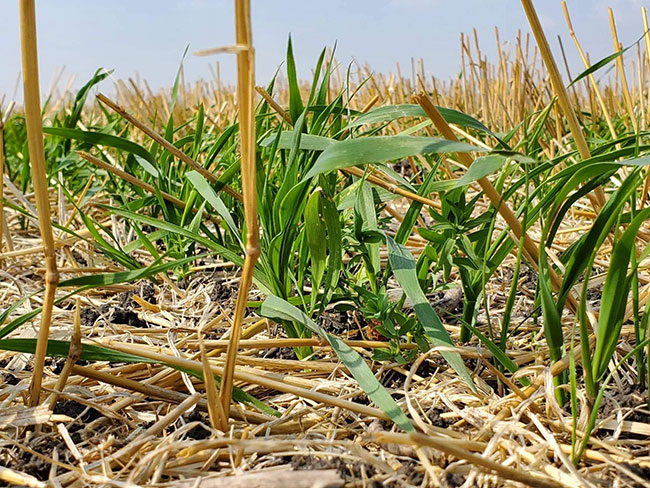 ABOVE: A cover crop of oats, canaryseed and flax in
Rosenfeld, Man. Improved soil health was seen as the most frequent benefit by 54 per cent of farmers. PHOTO COURTESY OF CALLUM MORRISON.
ABOVE: A cover crop of oats, canaryseed and flax in
Rosenfeld, Man. Improved soil health was seen as the most frequent benefit by 54 per cent of farmers. PHOTO COURTESY OF CALLUM MORRISON. To start the voluntary survey, social media was the initial method to contact farmers, and in the end, a good part of the survey came from farmers through social media contacts like Facebook. We also connected to agricultural organizations across the Prairies, and were in more than 80 media publications promoting the survey.
We heard from 281 farmers who grew cover crops in 2020, and from 247 farmers who didn’t grow cover crops.
One of the things that had to be decided at the start was how to define what cover crops are. There is a lot of innovation with forages, intercropping, and integrated crop and livestock systems. For the purposes of the survey, we defined it as any non-cash crops that were grown, and did include cover crops that were going to be grazed, green manures, and full season annual forages.
The shortness of the growing season is one of the driving factors in how farmers are doing things differently here. Another part of the challenge on the Prairies for cover crops is the environment, with periods of dryness in the fall making establishment difficult.
The survey results show the diversity of approaches from the early adopters of cover cropping, and some clear trends. The number of farmers responding was roughly one-third in each Province. Farmers were growing cover crops throughout most of the Prairies from Grande Prairie to the Red River Valley. This is an important message for agronomists and farmers to hear – that cover crops are grown in many different areas.
In the survey, of the 281 farmers that grew cover crops, 81 per cent grew a full season cover crop and 47 per cent grew a shoulder season cover crop. This covered 102,500 acres, with 55 per cent of the acres in shoulder season cover crops and 45 per cent were full season cover crops.
The percentage of farmers in each Province growing a full season cover crop was similar, but Manitoba farmers grew a higher percentage of shoulder season cover crops. This was probably due to better moisture and a longer growing season in Manitoba.
The most common cover crops grown were clover, grown by 57 per cent of respondents, and oats (52 per cent). Other popular cover crop species were peas (41 per cent), hairy vetch (37 per cent), and radish (36 per cent). Most were cold season cover crops. The cover crops grown were diverse with annual grasses, legumes and brassicas. These crops are very familiar, and for farmers getting started, they can look to crops they are familiar with.
Top 15 cover crop species grown by farms that responded
In terms of diversity, some are growing 10 or more species, but the majority are growing two or three species. If getting started, try two or three species because that helps to spread the risk of getting something established. There are also seed costs to consider when growing cover crops.
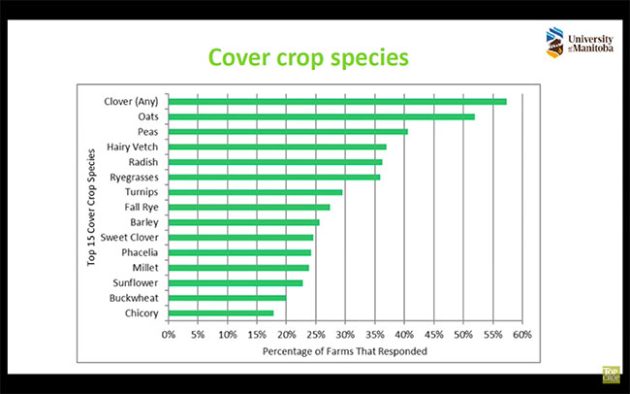
Courtesy of Callum Morrison and Yvonne Lawley, 2021.
Over a number of years, most farmers increased the number of species grown in a cover crop, with less than five per cent decreasing the number of species. Forty-five per cent of farms increased the number of species of cover crops over time, and 27 per cent did not change the number of species of cover crops.
One of the interesting findings was the importance of intercropping for Prairies farmers growing cover crops. A large proportion of farms are establishing their cover crops as an intercrop either at the same time as their cash crop (37 per cent) or by broadcasting their cover crop into their cash crop at some point during the growing season before harvest (14 per cent). It appears that some farmers are using intercropping as a way to get around the short growing season or dryness after harvest.
For termination, farmers are using species that will winter kill (37 per cent). Grazing to terminate cover crops (46 per cent) was also popular. As farmers get more experience, there may more overwintering cover crops that require termination with tillage or herbicides.
Ninety-one per cent of farmers said they saw at least one benefit from cover crops. The most common was improved soil health. They also said they saw increased biodiversity and organic matter, and less erosion. Some of these benefits increase over time, and others might be seen relatively quickly.
Benefits that have occurred growing cover crops
One surprising finding was how quickly farmers said they saw a benefit to cover crops. Over 35 per cent saw benefits from growing cover crops within one year. Roughly three-quarters of farmers saw benefits within the first three years of growing cover crops. The benefits they valued also probably change over time.
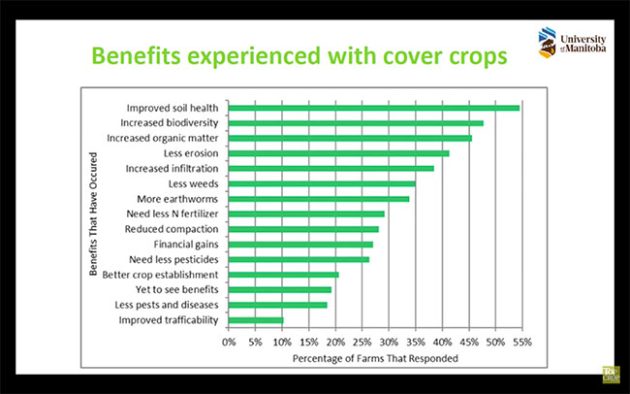
Courtesy of Callum Morrison and Yvonne Lawley, 2021.
Along with these benefits are real challenges. It is important for farmers to know those challenges, and also for policy makers to understand those as well. The most common challenge was the shortness of the growing season, experienced by 30 per cent of farmers.
Low moisture in the fall was also a challenge for 27 per cent of farmers. The additional costs of growing cover crops (25 per cent) and the impact of cover crop on herbicide choice (21 per cent) were also common problems identified by respondents. It appears these challenges are not insurmountable, and by identifying them, farmers can proactively innovate their way out of those challenges. But it also allows researchers and extension the opportunity to see where research needs to be targeted.
Top 15 problems experienced when growing cover crops
Cover crops are at a very early stage of adoption, and there are a few things that would encourage it. The survey found that top two practices to encourage farmers to grow cover crops were payments for storing carbon (59 per cent) and tax credits for planting cover crops (55 per cent). The implementation of these practices will be complex, but that is where farmers are looking to help cover some of the additional costs of cover crops.
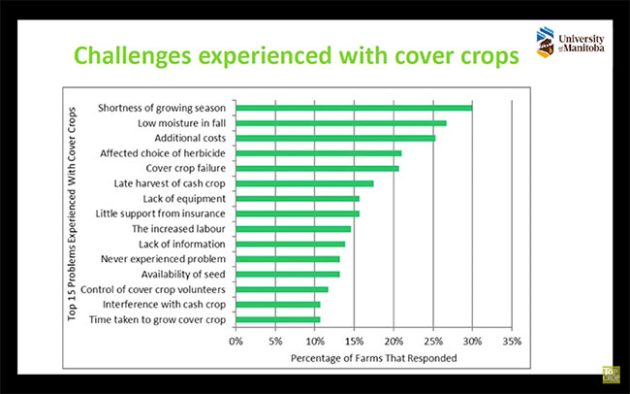
Courtesy of Callum Morrison and Yvonne Lawley, 2021.
Measures that would enable cover crop use
Other things that can be down to encourage the adoption is investing in research in local regions. Having information that is local would really help farmers. Also, providing technical assistance, access to information and extension, and economic and scientific data to support adoption were also measures mentioned to enable cover crop use.
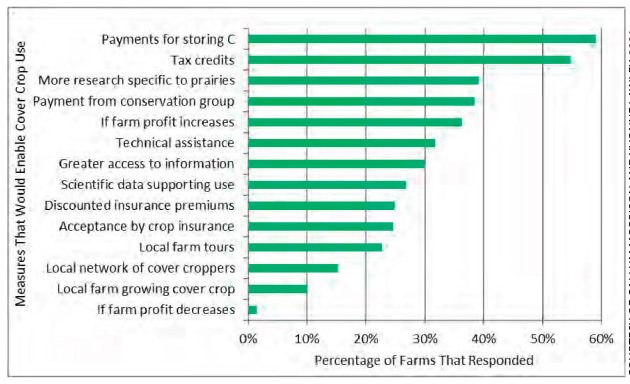
Courtesy of Callum Morrison and Yvonne Lawley, 2021.
The future of cover crops will be driven by farmers and their connections with each other. Ideas for innovation, how to adapt practices, and how to make it practical for Prairie farmers will help move the adoption of cover crops from the initial stages of early innovation to more wide-spread adoption.
Access the full survey report here: umanitoba.ca/agricultural-food-sciences/sites/agricultural-food-sciences/files/2021-10/2020-prairie-cover-crop-survey-report.pdf
Morrison, C.L., and Y. Lawley. 2021. 2020 Prairie Cover Crop Survey Report. Department of Plant Science, University of Manitoba. umanitoba.ca/agricultural-food-sciences/make/make-ag-food-resources#crops
Watch the presentation here:
umanitoba.ca/agricultural-food-sciences/make/make-ag-food-resources#crops